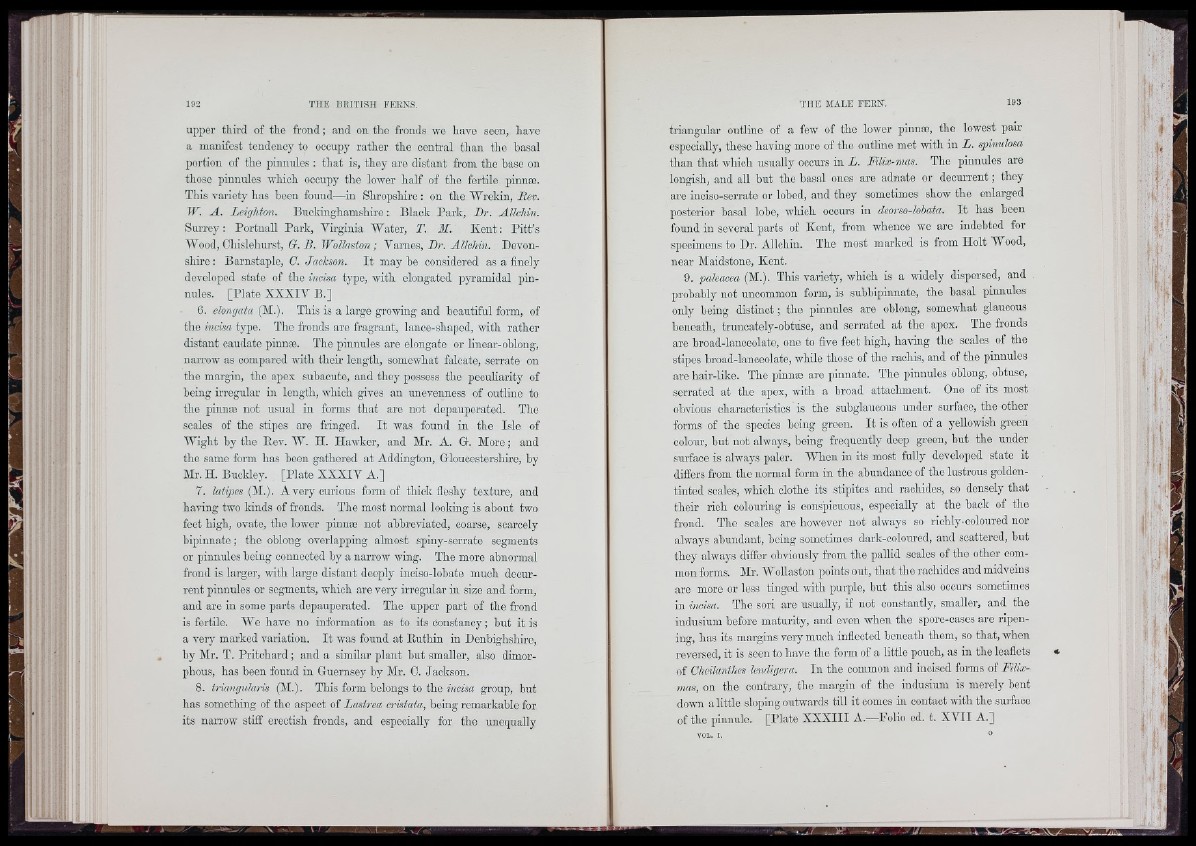
upper third of tho frond ; and on tho fronds wo have seen, have
a manifest tondcnoy to occupy rather tho central than the basal
portion of tho pinnules : th a t is, they aro distant from the base on
those pinnules wbicb occupy the lower half of the fertile pinnæ.
This variety has been found—in Shropshire : on the Wreldn, Rev.
IF. A . Leighton. Buokinghamshire : Black Park, Bn. Allchin.
Surrcj! : Portnall Park, Virginia Water, T. M. Kent: P itt’s
IVood, Chislehurst, O. B. Wollaston ; Varnes, Br. Allchin. Devonshire
: Barnstaple, C. Jackson. I t may bo considered as a finely
developed state of the incisa type, with elongated pyramidal pinnules.
[Plato XXXIV B.]
6. elongata (M.). This is a large growing and hcaiitiful form, of
the incisa fypo. The fronds aro fragrant, lance-shaped, with rather
distant caudate pinnæ. Tho pinnules are elongate or linear-oblong,
narrow as compared with thoir length, somewhat falcate, serrate on
the margin, the apox suhacuto, and they possess the peculiarity of
boing irregular in length, which gives an unevenness of outline to
the pinnæ not usual in forms that arc not depauperated. Tho
scales of the stipes are fringed. I t was found in the Isle of
Wight by the Eev. W. II. Hawker, and Mr. A. G. More ; and
the same form has been gathered at Addington, Gloucestershire, hy
Mr. H. Buckley. [Plate XXXIV A.]
7. latipes (M.). A very curious form of thick fleshy texture, and
having two kinds of fronds. The most normal looking is about two
feet bigb, ovate, the lower pinnæ not abbreviated, coarse, scarcely
bipinnate ; the oblong overlapping almost spiny-serrate segments
or pinnules being connootod by a narrow wing. The more abnormal
frond is larger, with large distant deeply inoiso-lobate much decurrent
pinnules or segments, which are very irregular in size and form,
and are in some parts depauperated. The upper part of the frond
is fertile. IVe have no information as to its constancy ; but it is
a very marked variation. I t was found at Euthin in Denbighshire,
hy Mr. T. Pritchard ; and a similar plant but smaller, also dimorphous,
has been found in Guernsey hy Mr. C. Jackson.
8. triangnlaris (M.). This form belongs to the incisa group, but
bas something of the aspect of Lastrea cristata, being remarkable for
its narrow stiff erectish fronds, and especially for the unequally
triangular outlino of a few of tho lower pinnæ, tho lowest pair
especially, these having more of tho outline met with in L . spinulosa
than that which usually occurs in L . Filix-mas. Tho pinnules are
longish, and all hut tho basal ones are adnate or docurrent ; they
are inciso-serrate or lohed, and they sometimes show the enlarged
posterior basal lobo, which occurs in deorso-lohata. I t has been
found in several parts of Kent, from whence wo aro indebted for
specimens to Dr. Allchin. The most marked is from Holt Wood,
near Maidstone, Kent.
9. paleacea (M.). This variety, which is a widely dispersed, and
probably not uncommon form, is suhbipinnate, tho basal pinnules
only being distinct; tho pinnules arc oblong, somewhat glaucous
beneath, trunoately-ohtuso, and serrated at the apex. Tho fronds
are broad-lanceolate, one to five feet high, having the scales of tho
stipes hroad-lanoeolate, while those of the rachis, and of the pinnules
are hair-like. Tho pinnæ aro pinnate. Tho pinnules oblong, obtuse,
serrated at the apex, with a broad attachment. Ono of its most
obvious oharaotoristics is the subglaucous under surface, the other
forms of the species being groen. I t is often of a yellowish green
colour, but not always, boing frequently deep green, hut the under
surface is always paler. When in its most fully developed state it
differs from the normal form in the abundance of the lustrous golden-
tinted scales, which clothe its stipites and raohides, so densely that
thoir rich colouring is conspicuous, especially at the back of the
frond. Tho scales aro however not always so richly-ooloured nor
always abundant, being sometimes dark-oolourod, and scattered, but
they always differ obviously from the pallid scales of the other common
forms. Mr. Wollaston points out, th a t the raohides and midveins
are more or loss tinged with purple, but tbis also ooours sometimes
in incisa. Tho sori are usually, if not constantly, smaller, and the
indusium before maturity, and ovon when the spore-oases are ripening,
has its margins very much inflected beneath them, so that, when
reversed, it is seen to have the form of a littlo pouch, as in the leaflets
of Cheilanthes lemligera. In the common and incised forms of Filix-
mas, on the contrary, the margin of tho indusium is merely bent
down a littlo sloping outwards till it comes in contact with the surface
of the pinnule. [Plato X X X III A.—Folio cd. t. X V II A.]